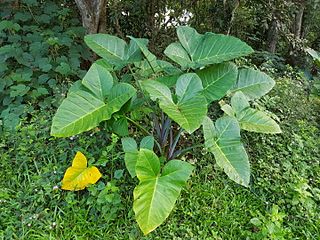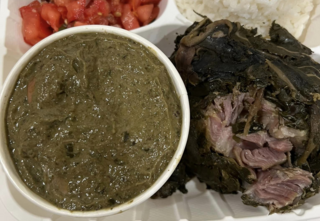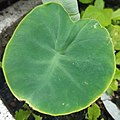
Corm, bulbo-tuber, or bulbotuber is a short, vertical, swollen underground plant stem that serves as a storage organ that some plants use to survive winter or other adverse conditions such as summer drought and heat (perennation).

Xanthosoma is a genus of flowering plants in the arum family, Araceae. The genus is native to tropical America but widely cultivated and naturalized in other tropical regions. Several are grown for their starchy corms, an important food staple of tropical regions, known variously as malanga, otoy, otoe, cocoyam, tannia, tannier, yautía, macabo, ocumo, macal, taioba, dasheen, quequisque, ʻape and as Singapore taro. Many other species, including especially Xanthosoma roseum, are used as ornamental plants; in popular horticultural literature these species may be known as ‘ape due to resemblance to the true Polynesian ʻape, Alocasia macrorrhizos, or as elephant ear from visual resemblance of the leaf to an elephant's ear. Sometimes the latter name is also applied to members in the closely related genera Caladium, Colocasia (taro), and Alocasia.

Taro is a root vegetable. It is the most widely cultivated species of several plants in the family Araceae that are used as vegetables for their corms, leaves, stems and petioles. Taro corms are a food staple in African, Oceanic, East Asian, Southeast Asian and South Asian cultures. Taro is believed to be one of the earliest cultivated plants.

Cocoyam is a common name for more than one tropical root crop and vegetable crop belonging to the Arum family and may refer to:

Eddoe or eddo is a tropical vegetable often considered identifiable as the species Colocasia antiquorum, closely related to taro, which is primarily used for its thickened stems (corms). In most cultivars there is an acrid taste that requires careful cooking. The young leaves can also be cooked and eaten, but they have a somewhat acrid taste.

Yam is the common name for some plant species in the genus Dioscorea that form edible tubers.

Patrode/Patrodo/Patra/Patrodu is originally a vegetarian dish from India. It is also known as Rikvach in Himachal Pradesh, Uttar Pradesh, and Bihar, Patrodé in Karnataka, Patra in Gujarat, Chembila Appam in Kerala, Alu Vadi in Maharashtra and Goa, Patrodu in Himachal Pradesh, Saina in Fiji, and Saheena in Trinidad and Tobago. It is a primary cuisine for the Konkani-speaking Gaud Saraswat Brahmin community (Patrodu). It is made from colocasia leaves stuffed with gram or rice flour and flavourings such as spices, tamarind, and jaggery.

Amorphophallus paeoniifolius, the elephant foot yam or whitespot giant arum, is a tropical plant native to Island Southeast Asia. It is cultivated for its edible tubers in Southeast Asia, South Asia, Madagascar, New Guinea, and the Pacific islands. Because of its production potential and popularity as a vegetable in various cuisines, it can be raised as a cash crop.

Alocasia odora is a flowering plant native to East and Southeast Asia. In Manipur, India, its local name is hoomu. Traditionally, A. odora is sometime used as a medicine for the treatment of the common cold in North Vietnam.

Xanthosoma sagittifolium(Tannia) is a tropical flowering plant from the family Araceae. It produces an edible, starchy corm. X. sagittifolium is native to tropical America where it has been first cultivated. Around the 19th century, the plant spread to Southeast Asia and Africa and has been cultivated there ever since. X. sagittifolium is often confused with the related plant Colocasia esculenta (Taro), which looks very similar and is also used in a similar way. Both plants are often collectively named Cocoyam.

A great variety of cassava-based dishes are consumed in the regions where cassava is cultivated, and the ingredient is included many national or ethnic specialities.

Manipuri cuisine refers to the cuisine of Manipur, a state of northeastern India. Daily meals are based on rice, with a few side dishes of vegetables, fish and meat. A meal would usually have a vegetable stew called ensaang or athongba, flavored with dried or fried fish; stir-fried vegetables called kanghou; and a spicy item, which could be morok metpa, eromba, or singju. All piquant side dishes are accompanied by a choice of fresh herbs, collectively called maroi. The base and essence of Meitei cuisine is the fermented fish called ngari. Several dishes of meat, mostly chicken and pork, are cooked with unique recipes. As a result of religious taboos, however, the Meitei Pangals do not cook the latter.

Cyrtosperma merkusii or giant swamp taro, is a crop grown throughout Oceania and into South and Southeast Asia. It is a riverine and "swamp crop" similar to taro, but "with bigger leaves and larger, coarser roots." There are no demonstrably wild populations today, but it is believed to be native to Indonesia. It is known as puraka in Cook Islands, lak in Yap, babai in Kiribati, iaraj in the Marshall Islands, brak in Palau, babaʻ in the Marianas Islands, pula’a in Samoa, via kana, Pulaka in Lau, Lovo in Fiji, pulaka in Tokelau and Tuvalu, mwahng in Pohnpei, pasruk in Kosrae, simiden in Chuuk, swam taro in Papua New Guinea, navia in Vanuatu and palawan in the Philippines.

Colocasia gigantea, also called the giant elephant ear or Indian taro, is a 1.5–3 m tall aroid plant with a large, fibrous corm, producing at its apex a whorl of thick, green leaves. In addition to its value as a starchy root vegetable—known by many names, such as taro, or arbi —the plant’s leaf stalk (petiole) is also used as a vegetable in some areas of Southeastern Asia and Japan.

Lūʻau, Luʻau, Laulau, Lū, Rourou, Rukau, Fāfā, Hāhā, and Palusami are all related dishes found throughout Polynesia based on the use of taro leaves as a primary ingredient. While taro generally is known as a root vegetable for its starchy corms, the leaves are consumed as well. The base recipe is vegetarian. Most often, coconut milk was added, and later meat or seafood. The texture of the dish range from a thick soup to a dense cake.

Yenakha Paotapi or Yenakha Paodabi Saijin Polibi, also known as the evil eavesdropper, is an old demoness. Stories often show her as an evil spirit. She lingers around the eaves of roofs in Meitei mythology and folklore of Ancient Kangleipak. She is described as the one who interferes everywhere. Legend says that she could not live with human beings. Instead, she lives like a dog or a jackal, sitting on graves. In some cases, she is depicted as a minor goddess in the Meitei religion.

Lai Khutshangbi (/laai-khoot-shaang-bee/) is a demoness (hingchabi) in Meitei mythology and folklore of Antique Kangleipak. She has very long hands. The word "Lai" means "deity or divinity," "Khut" means "hand," and "Sangbi" or "Shangbi" means "long" in Manipuri (Meitei). The legend says that when she walks, her long hands touch the ground. Her fingers are as sharp as thorns. She has a large mouth with a long tongue. Her appearance is very frightening.

The Hanuba Hanubi Paan Thaaba, also known as the Hanubi Hentak! Hanuba Hentak!, is a Meitei folktale of Ancient Kangleipak. It is about the story of an old man, an old woman and some monkeys.

Many pāmbīs play significant roles in the different elements of Meitei culture, including but not limited to Meitei cuisine, Meitei festivals, Meitei folklore, Meitei folktales, Meitei literature, Meitei mythology and Meitei religion (Sanamahism) of Kangleipak.

Animals have significant roles in different elements of Meitei culture, including but not limited to Meitei cuisine, Meitei dances, Meitei festivals, Meitei folklore, Meitei folktales, Meitei literature, Meitei mythology, Meitei religion, etc.

































